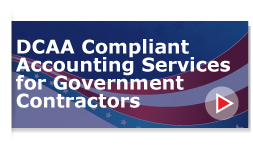
As a small government contractor you may be stretched for accounting resources, and if this is your first contract, that can be harmful. Learn about possible audits and be sure you're prepared for the Defense Contract Audit Agency (DCAA) audit process with this first-timer's guide.
While you could take the time to read through the 100 pages of the DCAA Information for Contractors Manual, you might be even more confused after trying to digest all the legal-ese. And, although the manual applies to all contractors, there are some issues that likely won’t impact small businesses like yours. Use this guide to wade through the requirements quicker and ensure you’ve checked off all the essentials.
Pre-Award Basics
Before you can even make a bid, you’ll have to justify your accounting system as DCAA compliant. In order to do that, you’ll complete the Preaward Survey (SF 1408 Criteria) form.
For this survey, you’ll need to prepare a narrative of your existing accounting systems and explain any deficiencies. Then you’ll complete the checklist in the second section. Maintaining adequate and reliable data in record keeping and providing support for requests for progress payment, the checklist includes several more requirements. The bad news is that it seems lengthy; the good news is that once you've met all of the requirements, the rest is a breeze.
Direct and Indirect Costs
Before looking at the checklist requirements, you need to understand direct and indirect costs as defined by DFARS 252.242-7006 (c)(3) and (c)(4). For government contracts, direct costs are “any cost that is identified specifically with a particular final cost objective.” These are not limited to materials and labor, but do have to result from the final cost objective.
Indirect costs are not associated with a single final cost objective, but are identified with an intermediate cost objective, or with two or more final cost objectives. These are usually tied to overhead or general and administrative costs, but can be a result of other categories as defined by the type and scope of the contract.
Allocation and Allowability
Differentiating between direct and indirect costs is required in order to properly allocate allowable costs pursuant to both Part 31 and also any differing agency supplements. While allocation of direct costs is more straightforward, the allocation of indirect costs must be:
- Reasonable, and
- Exhibit a relationship between pool costs and allocation base.
Determining the allowability of costs requires that the cost meets all of the following:
- Must be reasonable: “In its nature and amount, it does not exceed that which would be incurred by a prudent person in the conduct of competitive business.” (FAR 31.201-3)
- Must be allocable: Specifically for and necessary to the contract. (FAR 31.201-4)
- Satisfy terms of the contract.
- Meet applicable cost accounting standards (CAS).
- Observe any limitations as defined by Sub-part 31.201.
These definitions should help you complete the checklist of requirements for your accounting system.
The Checklist
These are the specific requirements that audits will consist of.
- Proper segregation of direct costs from indirect costs.
- Identification and accumulation of direct costs by contract.
- A logical and consistent method for the allocation of indirect costs to intermediate and final cost objectives.
- Accumulation of costs under general ledger control.
- A timekeeping system that identifies employees' labor by intermediate or final cost objectives.
- A labor distribution system that charges direct and indirect labor to the appropriate cost objectives.
- Interim (at least monthly) determination of costs charged to a contract through routine posting of books of account.
- Exclusion from costs charged to government contracts of amounts which are not allowable in terms of FAR 31, Contract Cost Principles and Procedures, or other contract provisions.
- Identification of costs by contract line item and by units (as if each unit or line item were a separate contract) if required by the proposed contract.
- Segregation of preproduction costs from production costs."
You’ll also indicate whether your system is in full operation. If it’s not, remember to explain why and when it will be.
After the survey is completed and submitted, an auditor may be asked to verify that the system requirements are met. The auditor will check your accounting system for each requirement as it applies to the potential contract. If no deficiencies are found, your system will be accepted as viable for contract use. If deficiencies are found, you and the contracting agency will be notified and you’ll be given recommendations to correct your system. After correction, the contracting agency may request a follow-up audit.
After the Contract is Awarded
There are circumstances in which a contracting organization may request an audit after the contract is awarded. This usually occurs if:
- No pre-award audit was conducted, or
- Deficiencies were originally found in the pre-award audit.
If this happens, be aware that DCAA objectives are there for your protection and generally concerned with reducing your accounting costs in addition to protecting government assets.
Regardless of whether the audit is conducted pre- or post-award, your bookkeeping system needs to be updated and functioning at peak performance. For additional information on the audit process, DCAA offers multiple resources for small businesses. Your contract is waiting. Get out there and win your award!














